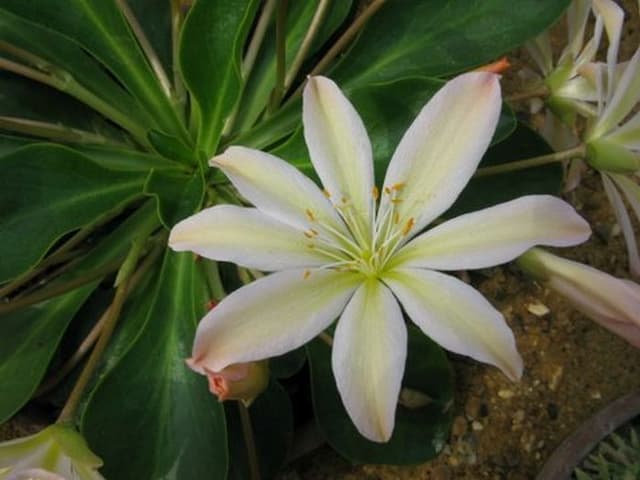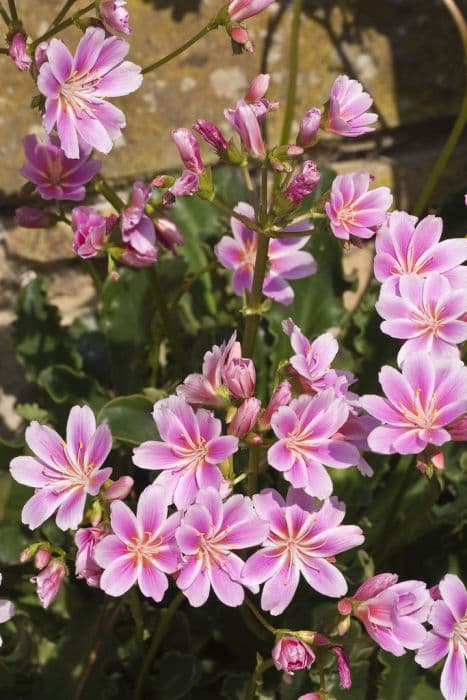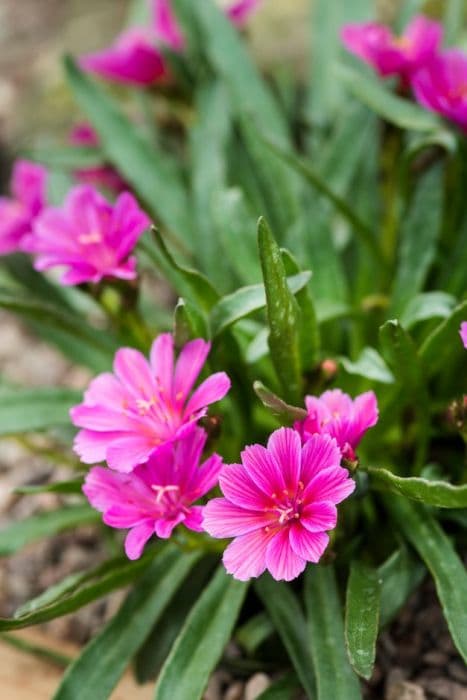Bitterroot Lewisia cotyledon Regenbogen (mixed)

ABOUT
The Lewisia cotyledon 'Regenbogen' is commonly known as rainbow Lewisia due to its colorful mix of blossoms. This perennial plant features fleshy, spoon-shaped leaves that form a rosette at the base. The leaves are bright green and may have a slightly waxy or succulent appearance that aids in water retention. From the center of the rosette, flower stalks emerge, topped with clusters of attractive blossoms that can come in a variety of shades—pink, orange, yellow, white, and sometimes bicolored petals that can have gradients or stripes, lending to the name 'Regenbogen', which means 'rainbow'. The flowers are star-shaped with numerous narrow petals radiating from the center, creating a delicate and intricate look. The center of each flower often displays a contrasting hue with golden anthers that stand out against the vibrant petals. The overall impression of the rainbow Lewisia is one of a lush, vibrant tuft of greenery from which emerges a colorful array of starry blooms, providing an eye-catching display in any garden setting. The plant is appreciated for its drought tolerance and its brilliant, long-lasting flowers that add a splash of color throughout the blooming season.
About this plant
 Names
NamesFamily
Montiaceae
Synonyms
Siskiyou Lewisia, Cliff Maids, Rainbow Lewisia
Common names
Oreobroma cotyledon
 Toxicity
ToxicityTo humans
Lewisia, also known as Siskiyou Lewisia or Cliff Maids, is not widely known for its toxicity to humans. There is limited information on whether Lewisia cotyledon causes any significant toxic effects when touched or ingested by humans. However, as with any plant, individual sensitivities can vary, and it is generally advised to avoid ingesting plants that are not specifically grown for consumption. If ingested, depending on individual sensitivity, symptoms might include gastrointestinal discomfort such as nausea, vomiting, or diarrhea. If you suspect poisoning from any plant, it is important to seek medical advice.
To pets
Siskiyou Lewisia, or simply Lewisia, is not commonly listed as toxic to pets, such as dogs and cats. Like most plants not intended for animal consumption, it could possibly cause mild stomach upset if ingested in large quantities. Watch for symptoms such as vomiting or diarrhea, as these are common signs of gastrointestinal irritation in pets. If you observe these symptoms or suspect your pet has ingested Lewisia, it is best to consult your veterinarian for advice.
 Characteristics
CharacteristicsLife cycle
Perennials
Foliage type
Evergreen
Color of leaves
Green
Flower color
Mixed
Height
1 foot [30 cm]
Spread
1 foot [30 cm]
Plant type
Herb
Hardiness zones
5
Native area
North America
Benefits
 General Benefits
General Benefits- Aesthetic Appeal: Lewisia cotyledon, commonly known as Siskiyou lewisia, has vibrant, multicolored flowers that enhance the visual appeal of gardens and landscapes.
- Drought Tolerance: Once established, Siskiyou lewisia is drought-resistant, making it suitable for xeriscaping and low-water gardens.
- Easy Maintenance: This plant requires minimal care beyond the initial planting period, so it's perfect for gardeners seeking low-maintenance options.
- Attracts Pollinators: The brightly colored flowers attract bees, butterflies, and other pollinating insects, supporting local ecosystems.
- Rock Garden Suitability: With its alpine origins, Siskiyou lewisia is an ideal candidate for rock gardens or areas with excellent drainage.
- Long Blooming Period: It has a long flowering season, which ensures that gardens have continuous color for much of the spring and summer months.
- Cold Hardy: Siskiyou lewisia is capable of withstanding cooler temperatures, making it suitable for gardens in many temperate regions.
 Medical Properties
Medical PropertiesThis plant is not used for medical purposes.
 Air-purifying Qualities
Air-purifying QualitiesThis plant is not specifically known for air purifying qualities.
 Other Uses
Other Uses- Lewisias, being naturally attractive, can be used in art and photography as subjects for botanical prints and close-up photography, capturing the distinctive patterns of their leaves and the vibrant colors of the blooms.
- In educational settings, lewisias can serve as an example in botany classes for studying alpine plant adaptations, such as fleshy leaves for water storage and ability to thrive in rocky soils.
- Their varied and vivid colors make lewisias excellent candidates for color therapy gardens, contributing to an environment designed to promote emotional well-being through visual stimuli.
- Lewisias can be integrated into living walls or vertical gardens as they are compact and can tolerate the well-draining conditions these structures provide.
- Rock garden enthusiasts often use lewisias to create miniature landscapes, taking advantage of their mountainous origin to recreate alpine scenes.
- In hobbyist craft projects, lewisia petals could be used for making natural dyes or inclusions in paper making, providing delicate colors and textures to the finished products.
- During festive seasons, lewisias can adorn holiday tables as part of live floral centerpieces, adding a unique flair with their succulent-like foliage and bright flowers.
- The plant's rosette form can inspire designs in areas such as jewelry or textiles, where their radial symmetry and color variations might be used in patterns or motifs.
- Lewisia flowers could be used in the kitchen as an edible decoration for desserts and salads, offering a mild taste and an enhancement of the dish's visual appeal.
- In a sensory garden, the textural differences between the fleshy leaves and the delicate flowers of lewisias can provide a tactile experience for visitors, especially for those with visual impairments.
Interesting Facts
 Feng Shui
Feng ShuiThe Lewisia is not used in Feng Shui practice.
 Zodiac Sign Compitability
Zodiac Sign CompitabilityThe Lewisia is not used in astrology practice.
 Plant Symbolism
Plant Symbolism- Tenacity: Lewisia cotyledon, commonly known as "Rainbow Lewisia" or "Siskiyou Lewisia," often grows in tough conditions in rocky crevices, symbolizing the ability to endure and thrive in challenging environments.
- Survival: This plant's capacity to survive with minimal soil and water reflects a symbol of resourcefulness and survival against the odds.
- Beauty in Adversity: Despite its often harsh growing conditions, Rainbow Lewisia produces vibrant, beautiful flowers, representing the concept of finding and showcasing beauty despite adversity.
 Water
WaterLewisia, commonly known as Cliff Maids or Rainbow Lewisia, should be watered sparingly. These plants prefer to dry out between waterings, so a good rule of thumb is to water them once a week or less frequently, depending on the humidity and temperature. The method of watering should involve pouring water directly onto the soil rather than spraying the foliage, to avoid rot. As for the amount, providing them with about 8-12 ounces of water every week should be sufficient, but always check the soil moisture level before watering again.
 Light
LightRainbow Lewisia thrives best in bright, indirect sunlight. A spot that receives morning sun and afternoon shade is ideal to prevent the leaves from scorching. Avoid placing them in full, harsh sunlight during the hottest parts of the day to maintain the vibrant colors and health of the leaves.
 Temperature
TemperatureRainbow Lewisia prefers a temperate range with cool nights and warm days. They can survive minimum temperatures down to about 20 degrees Fahrenheit, but the ideal temperature range for them lies between 40-75 degrees Fahrenheit. These plants may be at risk if exposed to temperatures above 90 degrees Fahrenheit for prolonged periods.
 Pruning
PruningPrune Rainbow Lewisia to remove dead or withered flowers and foliage to encourage new growth. Pruning is best done after the blooming season, usually in late summer or early fall. Do not prune too heavily; instead, focus on tidying up the plant to maintain its attractive appearance.
 Cleaning
CleaningAs needed
 Soil
SoilBitterroot prefers well-draining soil with a rocky or sandy component, akin to its native alpine environments. A recommended mix might include equal parts potting soil, coarse sand or perlite, and fine gravel or pumice. The ideal soil pH for Lewisia cotyledon, or Bitterroot, is slightly acidic to neutral, around pH 6.0 to 7.0.
 Repotting
RepottingBitterroot doesn't need frequent repotting; it should be done every 2-3 years or when it outgrows its container. Care should be taken when repotting to avoid damaging the fleshy roots.
 Humidity & Misting
Humidity & MistingBitterroot thrives in moderate to low humidity levels, typical of its native mountain habitat. Avoid high humidity conditions which can promote rot.
 Suitable locations
Suitable locationsIndoor
Place Bitterroot in bright light, away from direct heat sources.
Outdoor
Plant Bitterroot in a sunny spot with good drainage.
Hardiness zone
5-8 USDA
 Life cycle
Life cycleThe life of Lewisia cotyledon, commonly known as Siskiyou lewisia, begins with seed germination, which typically occurs in late winter to early spring when moisture and temperature conditions are favorable. The seedlings develop into rosettes, a cluster of fleshy leaves close to the ground, a stage that may last for one or more seasons as the plant establishes itself. As the plant matures, it forms a deep taproot that helps it survive in rocky, well-drained soil. Flowering occurs in late spring to early summer, with clusters of star-shaped flowers blooming in a range of colors atop slender, leafy stalks. After pollination, typically by bees and other insects, the flowers develop into capsules containing numerous tiny seeds, completing the reproductive cycle. The plant may die back following seeding, but the taproot can give rise to new growth in the following growing season, making it a perennial.
 Propogation
PropogationPropogation time
Spring to early summer
The most popular method for propagating Lewisia cotyledon, commonly known as Siskiyou lewisia, is through seed sowing. This is best done in fall or late winter, allowing a natural cold stratification period which can be mimicked by placing the seeds in a refrigerator for about three weeks before sowing. After stratification, sow the seeds on the surface of a well-draining soil mix, as they require light for germination. Cover the container with a plastic wrap or a glass pane to retain moisture, and place it in a bright area with indirect light. Keep the soil consistently moist but not waterlogged. Seedlings will emerge in approximately two to four weeks at temperatures around 60 to 70 degrees Fahrenheit (15 to 21 degrees Celsius). Once the seedlings are large enough to handle, they can be transplanted into individual pots or into the garden.




